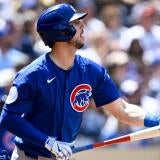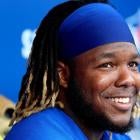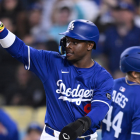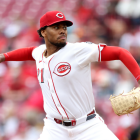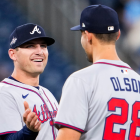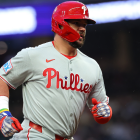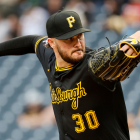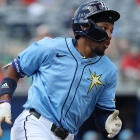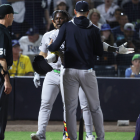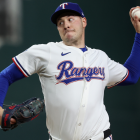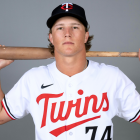With the regular season a month away, it's time to partake in the fool's errands of spring. That includes picking a breakout player for every team. We had a so-so batting average in 2019, hitting on nine or 10 of our 30 picks, depending on the ruling judge. We did have a good ISO, however, as our selections included Ketel Marte, DJ LeMahieu, and Max Kepler. (To be clear, we're not suggesting we anticipated them playing quite as well as they did last season.)
We're upping the difficulty level this year by avoiding fashionable picks, save for an instance or two where there was no other option. Otherwise, we tried picking under-the-radar players who were likely to 1) spend ample time on the 26-man roster and 2) outperform expectations.
Obviously this is a subjective exercise -- and one that tends to skew young and reliever, since there's more opportunity there -- so bear that in mind as you scroll through the picks.
| Stefan Crichton: What better way to start than with a 28-year-old reliever who has a 4.85 ERA in 36 big-league appearances? Crichton comes at batters with two pitches: a low-to-mid-90s sinker and a curveball that he can throw in and outside the zone, depending on the situation. The breaker is the more effective offering, as last season it generated a .067 batting average against and a whiff rate higher than 50 percent. Crichton does not have the high-end stuff necessary for a high-leverage role, but he should be an adequate middle reliever who can fill up the zone and coerce a timely double-play ball when needed. | |
| Adam Duvall: We're resisting the urge to pick a young arm in deference to Duvall, whose outlook hinges in part on the baseball. Duvall tends to get underneath the ball, to the extent that his launch angle (26.2 degrees) was the third-highest in a season since 2016 for a batter with 100-plus plate appearances. That he hit .267 (in 41 games) with that kind of geometry is more impressive than it seems -- of the 32 individual seasons where a batter had a higher launch angle than the Gallo Line (that is, Joey Gallo's career 21.4 degree launch angle), the median batting average was .220. Duvall doesn't walk often, so the ball's liveliness could dictate if he's a productive bat off the bench, or someone who will be cast aside by the time August rolls around. | |
| Hunter Harvey: If you're familiar with prospects, then you're familiar with Harvey, who has been on the radar since he was selected 22nd overall in 2013. He threw 82 innings between the majors and minors last season, which sounds like nothing; except he threw 63 innings combined from 2015-18. Injuries have derailed Harvey's starting career, but he might yet make good as a reliever thanks to special arm strength that lets him sit in the upper-90s. Brandon Hyde's most reliable reliever is his post-game Tylenol, so don't be surprised if Harvey gets a chance to pitch in high-leverage situations before the season is out. | |
| Austin Brice: Yes, another late-20s reliever. Brice has changed teams five times since January 2017, including most recently in January, when he was sent to the Red Sox in a minor deal. There's more promise here than his career 87 ERA+ (in more than 100 big-league appearances) suggests. Indeed, Brice seems to be a prime candidate for arsenal optimization. Last season, his four-seamer and curveball (a slider to these eyes) combined for a batting average against of less than .180 and a whiff rate over 30 percent, yet accounted for just over three-quarters of his pitches. (The rest were sinkers and changeups.) We'd like to see Brice lean into being a two-pitch reliever. If he does, he just might stick with one team for a while. | |
| Steven Souza: No one on this list has had a less enjoyable two-year run than Souza. He posted a career-worst effort in 2018, then missed all of the 2019 season due to a knee injury. Now he's back, and in a good spot for a right-handed outfielder: starters Kyle Schwarber and Jason Heyward are each lefties, meaning they'll need days off against southpaws. Souza hasn't been so productive against lefties (.759 career OPS) to earn the vaunted "right-handed masher" label, but his combination of patience and power should make him a useful caddy, at minimum. | |
| Dylan Cease: Mark us down for Zack Collins once robot umpires are installed. Until then, we'll roll the dice with Cease, who has big-time stuff and big-time command problems. During his 14-game stint in the majors in 2019, he averaged more than four walks and nearly two home runs per nine innings. The walks might stick, but our guess is the dingers won't: Cease's average exit velocity and launch angle allowed were right in line with the big-league average. | |
| Lucas Sims: From our recent post on out-of-options players: Sims introduced a sweeping slider late in the season to promising returns. Opponents hit .167 and whiffed on 55 percent of their swings against the pitch. He imparts well-above-average spin on all his offerings, and his history as a starter could tempt a team to use him as an opener and/or as a bulk pitcher. | |
| Daniel Johnson: Cleveland has developed the young outfielder version of tsundoku, leaving them with a lot of bodies to sort through over the coming months. Johnson is likely to get the call at some point, and when he does we think he'll make the most of his opportunity. He's a quality athlete with a big arm who could mature into a plus hitter. Johnson pulled the ball more often and hit for greater power in 2019, quieting concerns about the usability of his strength. | |
| Ryan McMahon: At a fundamental level, the two most important things a batter can do is to mind the zone and to hit the ball hard. McMahon's results don't show it (he has a career 82 OPS+), but he checks off both boxes. He's walked in more than 10 percent of his plate appearances, and he has resisted chasing at rates better than the league-average. McMahon is prone to swinging and missing, yet when he connects he tends to make good contact: he ranked 22nd among qualifiers last season in exit velocity, and did it with a launch angle similar to the ones posted by Shin-Soo Choo, Eloy Jimenez, and Franmil Reyes -- or, three above-average hitters. The Rockies were a disappointment factory in 2019, and it's possible McMahon gets lost in the shuffle behind Brendan Rodgers and Garrett Hampson. For now, though, we like his chances of turning in his first above-average offensive season in 2020. | |
| Daniel Norris: It might be cheating to include Norris after last season, when he threw a career-high 144 innings and had a 107 ERA+ and a 3.29 strikeout-to-walk ratio. We're doing it anyway because the Tigers lack alternatives, and because it's only right that Norris receives the victory-lap nod given the portfire-like slow burn of his career. There were two major developments worth noting during his 2019. One came on the pitch-usage front, where at season's end he was throwing his fastball at a career-low frequency and his changeup at a career-high frequency. The other entails his late-season deployment, as the Tigers limited him to three innings per outing over his last nine appearances. He posted a 3.33 ERA and struck out nearly four times as many batters as he walked in those starts. We're guessing the new-look Norris will get to work into the fourth inning and beyond this season, so stay tuned to see how it goes. | |
| Bryan Abreu: It feels like Abreu's introduction to the majors late last season happened a decade ago. In case you don't recall: he struck out 13 of the 32 batters he faced over a seven-game stretch, coercing whiffs on 46.8 percent of opponent's swings. The Astros lost Will Harris without adding a veteran late-inning arm, which would seem to open the door for Abreu to slide into a high-leverage role as soon as this season. There is a caveat to keep in mind, and that concerns Abreu's wildness. His well-below-average command led him to walk more than five per nine in the minors in 2019, and it could hinder his ascent if batters refuse to expand the plate. | |
| Scott Barlow: This Royals roster doesn't feature many legitimate candidates (we're giving Adalberto Mondesi credit for "breaking out" in 2018), so we'll give the nod to Barlow. He struck out nearly 30 percent of the batters he faced last season, and did so while evading lumber on more than a third of the swings taken against his pitches. For reference, that puts him in the same class as Max Scherzer and Justin Verlander. There's no real sense in worrying about who'll close when Ian Kennedy gets traded, but Barlow is a decent candidate to take the reins. | |
| Luis Rengifo: Rengifo was supposed to be included in that swap with the Dodgers that involved Joc Pederson and Ross Stripling. Owner Arte Moreno's impatience caused the deal to fall through, but holding onto Rengifo could pay off for the seraphs. He's a well-rounded talent who plays good defense, can run a bit (though it didn't show up in the stolen-base column last year), and minds the zone. His exit velocity was close to the league-average mark, too. Rengifo just turned 23 years old, suggesting there's room for growth. He should be at least a bench piece, and, with some additional refinement, he could become even more than that. | |
| Brusdar Graterol: You have to feel for Graterol. He has a high-grade arm, with two very good pitches in his fastball and slider. But since the original Mookie Betts trade leaked all anyone can talk about are his medicals and his relief projection. The best way to put the noise behind him is to win a high-leverage role with the Dodgers before celebrating his 22nd birthday in August. | |
| Jeff Brigham: The Marlins originally acquired Brigham as part of a massive (in scope, not impact) three-team deal at the 2015 deadline. If his results can match his stuff, they might end up parting with him at this year's deadline. Brigham's approach is half-and-half: half mid-90s fastballs with good spin, half above-average sliders. That formula enabled him to miss an above-average amount of bats last season. Brigham did give up too many home runs, but any kind of regression on that front should make him an appealing middle-relief option. | |
| Drew Rasmussen: Corbin Burnes would be a good and defensible pick here, but we're going off the board with Rasmussen. Of his 27 appearances last season, 22 of them came in Double-A. Why is that notable? Because it was his first professional season, having missed 2018 due to his second Tommy John surgery. Rasmussen has a good fastball-breaking ball combination and there's no reason to hold him in reserve for long. Provided he's healthy, he should be up early and often, presumably as a member of Milwaukee's bullpen. | |
| Matt Wisler: Congratulations to Mr. Wisler, who also appeared on last year's list. We wondered then if he would lean into his slider more often. He did, throwing it more than 70 percent of the time. His peripherals were quite good, too: 11 strikeouts per nine, nearly four strikeouts per walk, and so on. Obviously something went wrong for Wisler to end up on here again, and yes, something did indeed go wrong: his ERA was an unsightly 5.61 due to homer woes. We still believe, oh, we still believe. | |
| Amed Rosario: Sometimes it's easy to lose sight of what a player can do by focusing too much on what they can't do. Rosario's substandard shortstop defense (he's particularly poor going to his right) will probably land him in center field someday, where his top-end footspeed could make him an asset, but that possibility shouldn't obscure his offensive charms. He hit for roughly league-average marks last season, and did so while improving upon his launch angle, exit velocity, power output, and strikeout rate. Though betting on anyone to follow Ketel Marte's path to stardom is a silly enterprise, there are some similarities between the two. Let the record show that Rosario has, at minimum, outpaced what Marte did through his age-23 campaign. | |
| Jonathan Loaisiga: Luis Severino and James Paxton's health woes, combined with Domingo German's suspension stemming from his violation of the domestic violence policy, may cause Loaisiga to open the season in New York's rotation. Loaisiga has a live arm that is capable of producing upper-90s velocity as well as imparting good spin on all of his pitches. He hasn't yet found success in the majors, and recurrent injuries have cast doubt on his long-term starting prospects, but it seems like a matter of when things will click into place, as opposed to if. | |

Athletics
| |
| Jesus Luzardo: Luzardo shares initials and concerns with Loaisiga. He'll turn 23 in September, but has so far thrown more than 100 innings in a season just once. Heck, last year he threw 55 innings between the minors and the majors, and that was the second-highest total of his career. A hearty and hale Luzardo has three above-average pitches and a good feel for the zone. All that's separating him from being the leader of the A's rotation is a clean bill of health. | |
| Zack Wheeler: Typically, a player who has reached free agency and signed a contract worth more than $100 million is either too good to have a "breakout" season, or has already maxed out their abilities. We think Wheeler could be the exception. He has almost all of the innate characteristics of a front-of-the-rotation starter: a hot fastball; a pair of swing-and-miss secondaries; strike-throwing ability; athleticism; and so on. (It can't hurt that he got away from the Mets' poor defense and lagging analytics department, either.) The Phillies could well come to regret banking on Wheeler's upside, but there's a real chance his deal ends up a bargain. | |
| Chris Stratton: Also from our recent piece on out of option players: Stratton found a semblance of success with the Pirates in a relief role, posting a 117 ERA+ in 46 innings and striking out more than a batter per inning. He'll turn 30 in-season and he'll be arbitration-eligible afterward, so keep his name in mind at the deadline if he performs well. | |
| Andres Munoz: Shout out to Trent Grisham, a respectable selection whose gains last season were overshadowed by his misplay in the Wild Card Game. We're going with Munoz instead because he struck out more than 30 percent of the big-league batters he faced in 2019 despite being 20 years old with limited experience above Double-A. Munoz does not have graceful mechanics -- he has an abrupt arm stroke that sees his back elbow drift above his shoulder, and his delivery also features crossfire action and him falling off the mound upon release -- and there's always going to be concerns about his long-term viability. For as long as he can stay healthy, he has a chance to be a late-inning dynamo. Munoz averaged 99.9 mph on his fastball during his big-league stint, and he generated whiffs on nearly half the swings taken against his above-average slider. He's going to walk his fair share of batters, but that San Diego bullpen could be biting -- and he'll serve as a molar. | |
| Steven Duggar: Duggar is probably a fourth outfielder on a team with more outfield options. He's a quality defender, one who grades especially well through the lens of ball-tracking data. Duggar isn't nearly as proficient offensively, as he's batted .283 and homered nine times in 114 career games in the Pacific Coast League, meaning there's a cap on his ceiling. Perhaps Farhan Zaidi finds some magical beans and uses them to teach Austin Slater how to lift the ball, or Joe McCarthy how to stay healthy. Weirder things have happened. | |
| Jake Fraley: Choosing Kyle Lewis would feel cheap, so Fraley gets the nod. He hit the ectoplasm out of the ball in Double-A, and later earned a brief look in the majors, during which he... well, didn't hit the ectoplasm out of the ball. Fraley approached big-league pitching like he was partaking in the home-run derby, offering at almost 80 percent of the pitches he saw in the strike zone, and getting underneath far too many to be productive. (He also didn't walk in any of his 41 trips to the plate.) Some of the game's better hitters are aggressive within the zone -- Jeff McNeil and Freddie Freeman each had in-zone swing rates over 80 percent last season -- so we'll chalk up Fraley's struggles in 2019 to small-sample size and give him another chance to develop into the well-rounded, second-division outfielder that his boosters believe he can become. | |
| Lane Thomas: The Cardinals overhauled their depth chart over the winter as it pertained to right-handed outfielders by permitting Marcell Ozuna to walk and trading Jose Martinez and Randy Arozarena (for Matthew Liberatore). Those moves should free up playing time for Tyler O'Neill and our highlighted lad Thomas, who performed well last season (.316/.409/.684) in a small-sample size (44 plate appearances). For entertainment purposes only, it's fun to note that his launch angle and exit velocity were similar to the aforementioned Martinez's. Thomas probably won't outhit Martinez heading forward, but he's a better runner and outfielder, and that should make up for the difference. | |
| Colin Poche: Earlier this winter, we noted the following about Padres reliever Trey Wingenter: There were 13 pitchers with 40-plus innings last season who: 1) fanned 30 percent or more of the batters they faced; and 2) permitted no more than six hits per nine. Of those 13, eight of them finished with ERA+ better than 150 and three topped 115. The two others were Colin Poche (95), and yes, Wingenter, who somehow checked in at 75. In other words, we think Poche and his invisiball will have a better ERA in 2020. | |
| Rafael Montero: For those wondering, this is indeed the same Montero who used to be a No. 4 starter prospect with the Mets. He resurfaced in Texas' bullpen during the second half of last season, showing increased velocity (his heater averaged 96 mph) and an altered pitch mix that relied less on his fastball and more on his changeup. Montero was even able to avoid the free pass, as he recorded 19 strikeouts and zero walks over his final 13 outings. He won't keep that pace up, but serving as a capable middle reliever would make him a fruitful buy-low signing. | |
| Vladimir Guerrero Jr.: Hey, not every pick has to be of the baseball hipster variety. Guerrero, 21 in March, did a lot of things well during his rookie season. He hit the ball harder than the league-average mark, he kept his strike zone in order, and he hit .306 against fastballs with a .475 slugging percentage. The main areas where he needs to improve are his defense and his launch angle, as he hit the ball on the ground more than 50 percent of the time. Ideally, Guerrero would lift the ball more often, better leveraging his immense raw strength. If he can do that heading forward, beginning in 2020, then he's going to be just fine. | |
| Austin Voth: To win a championship, a team often needs players to overperform. The Nationals had that happen, then brought back most of the same team. The outside additions they did make don't scream "breakout," so we're going with Voth. He's on the older side (he'll turn 28 in June) and his arsenal isn't going to win any awards from Pitching Ninja, but he's out of options and should break camp with the club, either as a starter or as a reliever who can provide length. | |
![[object Object] Logo](https://sportshub.cbsistatic.com/i/2020/04/22/e9ceb731-8b3f-4c60-98fe-090ab66a2997/screen-shot-2020-04-22-at-11-04-56-am.png)

































